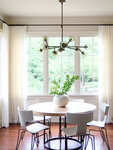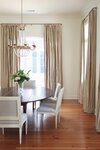






To Lisa Palmer, interior designer and owner of SummerHouse in Ridgeland, window treatments are strongest when clean, classic, and unfussy. As an expert on the décor and covering of windows, she has quite a few tips for anyone looking to spruce up their own windows.
An unfussy approach to window treatments means avoiding the temptation to obstruct views in favor of gimmicks. Some windows might have beautiful views and encumbering those views will not do a room any favors. In the South, with so much sunlight streaming into open concept homes, window treatments can actually be used for energy efficiency. They also soften the space and give privacy.
One of the first things Palmer considers for her window treatments is window length and how to lengthen the space. Window treatments should not begin right at the frame, because this creates too much negative space in the window’s midsection.
“I like to use window treatments to add design to a room, to add interest, texture, as well as functionality of being able to have privacy and energy efficiency, keep your rooms cooler in the summer and warmer in the winter,” says Palmer. “But, they’re really just a design element for me.”
When planning a window treatment, homeowners are advised to keep their environment in mind. The morning sun is the brightest, and the afternoon sun the hottest, so Palmer will stay mindful of that information when lining window curtains.
“Blackout lining is not the old blackout lining,” she says. “When you went to the Motel 6 when you were young, that vinyl-feeling, rubberized blackout lining like they used to use? It’s not like that anymore. It’s supple, it moves, it’s soft, but it blacks out your room.” Dim-out is another option. If you struggle with migraines or insomnia, blackout or dim-out curtains may be a healthy option for you.
Silk on its own is a major window treatment faux pas, in Palmer’s opinion. “I would never use silk in a window that’s going to get a ton of light, especially a colored silk,” says Palmer. Sunlight will fade drapery, whether it’s silk or not. In particular, silk curtains or drapes will be shredded by the inexorable heat of the sun. Palmer has some experience in replacing that kind of sun fading or shredding incident.
Instead, she suggests polyester as a curtain or drapery fabric. Polyester is known for being a little more stain- and sun-resistant. SummerHouse also uses linen blends or cotton-linen blends for the added heaviness to make for a prettily supple drape.
“With silk, I’ll use what they call bump, which is not interlining, it’s thick,” says Palmer, who compares bump to a thick flannel. “Because silk is so thin, it not only protects the silk, but it gives you these gorgeous folds when you’re pleating. There’s not a single seamstress in New Orleans that will not use bump with silk. It’s just what they do, and they know what they’re talking about.”
For Palmer, the world of window treatments is not particularly fraught with danger or unfashionable choices. However, she still has advice on things to avoid. Un-lined drapery is her pet peeve. Palmer interlines and lines her drapery for the added thickness and protection from outdoor heat. If her client wants to avoid a darkening effect, she will line sheer with sheer to allow light to come through.
“And there are some window treatments that don’t call for full-length drapery. You might want to do café curtains,” she says. This is where Palmer would drop the rod to three-quarters of the way down and hang a beautiful sheer to allow some natural light coming in from above. This is an especially good option for tall windows.
“And some windows only require Roman shades,” Palmer points out. “SummerHouse now does motorized: motorized drapery and motorized Roman shades.” Clients can press a button and open or close their windows from the comfort of their beds.
While lining curtains is an extra step you can take to protect your fabric, Palmer has advice on how not to overdo your window treatments too.
“I don’t love shutters,” says Palmer. Shutters take away from the flow of a room and introduce more wood into a house, a heavy-handed effect especially if the floors are hardwood. “An old cabin with original shutters, I probably won’t touch them. But I don’t love plantation shutters. They’re functional, but there’s no design to them. I see a window as an opportunity to add interest to the space.”
Kitchens are relatively simple. Here, you can add interest without fuss. Consider avoiding heavy curtains or drapes. “You’ve got food slinging around,” Palmer points out. Roman shades are the way to go, because of their advantages in blocking sunlight. “You have to make sure the cord is long enough,” Palmer adds, “because you’ll be reaching over that sink to get it.” The kitchen is another place where that motorized trend might be advantageous.
Another trend Palmer has noticed in recent years is a swerve away from the plain: solid, line, white. Palmer has found that color and trimmings are making a noticeable comeback in interior design. “Bullion fringe is really coming back. Tassel fringe, beautifully-embroidered braids used as trimmings, and patterned drapery are all nods to tradition and they’re very popular right now,” she says.
Palmer also notes that SummerHouse avoids investing too much in trends, because window treatments are costly enough that they should be meant to last a long, long time. Ultimately, while some choices can lengthen a window treatment’s life expectancy or avoid cluttering up a space, your needs come first.
“I design for my client,” says Palmer. “There’s no hard and fast rule in design right now. If they love purple, I’m going purple. If they love green, I’m going green. I design what makes my clients feel great in their home.”
Palmer also encourages those looking to spruce up their windows to seek a professional’s opinion before tackling that challenge. “If you have a budget, and you say, ‘I don’t want to go over this,’ please come see us. I think window treatments are the beautiful coat or wrap to a pretty black dress. You can level up a room by just adding that, and it finishes the room like no other.”
Further information about home décor, fabulous interior designers, and SummerHouse can be found at summerhousestyle.com or at the Madison and Oxford locations.